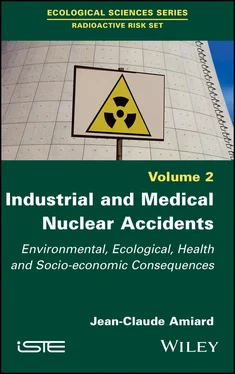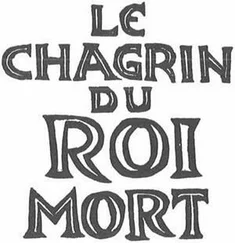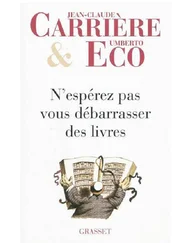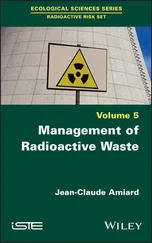These are not the only reactors whose cores have suffered. For example, according to Wing and Hirsch [WIN 06], at least four of the reactors located at the Santa Susana Field Laboratory (SSFL) site have suffered such accidents. These are the AE6 reactor which suffered a release of gaseous fission products into the environment in March 1959, the SRE which had a power excursion and partial core meltdown in July 1959, the SNAP8ER which in 1964 suffered 80% damage to its nuclear fuel and the SNAP8DR which in 1969 suffered similar damage to one-third of its nuclear fuel. Let us also recall the accident in 1961 of the Idaho Falls SL-1 experimental reactor discussed in the previous volume [AMI 19], or that of the Jaslovske Bohunice reactor (Czechoslovakia) in 1977, but where the consequences were much more limited.
For nuclear workers, the number of accidents with clinical consequences is limited and tends to decrease for criticality accidents. On the contrary, the number is greater and tends to increase for accidents with radionuclides and especially for accidents related to sealed sources (Figure 1.2).
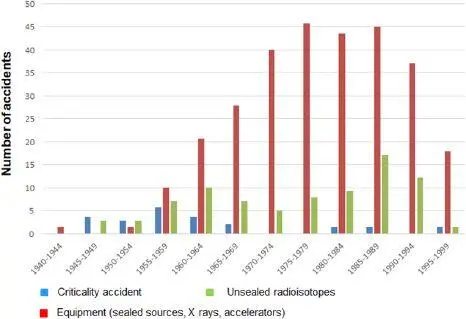
Figure 1.2. Trends in the various types of nuclear and radiological accidents with clinical consequences for nuclear workers (adapted from [UNS 00a]). For a color version of the figure, see www.iste.co.uk/amiard/industrial.zip
1.6. Information on nuclear energy
For a long time, public information on radioactive risk has been deficient and even biased, not only in the military field but also in civilian applications of atomic energy. Thus, most of the accidents that occurred in the 1950s and 1960s were kept secret. It was only after the Three Mile Island accident in 1979, and especially the Chernobyl accident in 1986, that public information became more free and taken seriously. The IAEA has mainly developed its communication policy since 1990.
In France, public information on nuclear events is provided by the ASN, created only in 2006. Level 0 incidents, about a thousand per year, are not systematically made public. They may be published if they are of particular media interest. All incidents classified at level 1 and above are systematically reported on the ASN website. Annually, there are approximately a hundred level 1 cases in France. Information on incidents at level 2 and above are published and, in addition, brought to the attention of journalists through press releases and telephone contact. In France, they only represent a few cases per year.
A follow-up of nuclear incidents was set up in 2001 by the CEPN and the group Personnes Compétentes de la Société Française de Radioprotection (SFRP), in cooperation with the IRSN and INRS. It is the RELIR system ( http://relir.cepn.asso.fr/) that brings together the most interesting events for worker training and incident prevention. The selected incidents are presented in the form of descriptive sheets guaranteeing the anonymity of the exposed persons, companies and materials involved.
2
Accidents Related to Nuclear Power Production
2.1. Introduction
In the first volume of this series on radioactive risk, we have reviewed nuclear accidents of military origin. We must now address civil nuclear accidents. Atomic energy is mainly used to produce electricity in nuclear reactors and relies on a set of industries capable of extracting, concentrating, transforming, using, reprocessing and reusing nuclear fuel (mainly uranium and plutonium). Nuclear accidents can occur at any stage of the fuel cycle. However, unfortunate experience has shown that nuclear reactors and spent fuel reprocessing plants are the most frequent and most serious locations for accidents. The consequences of accidents remain local when releases are low, regional for medium releases and global only for the most serious accidents.
2.2. Accidents in the nuclear fuel cycle
The nuclear fuel cycle is shown in Figure 2.1. To our knowledge, there have been no significant incidents in mines and factories where nuclear fuel is concentrated, converted and enriched. Significant incidents and accidents have occurred in manufacturing plants, nuclear reactors and spent fuel reprocessing plants.
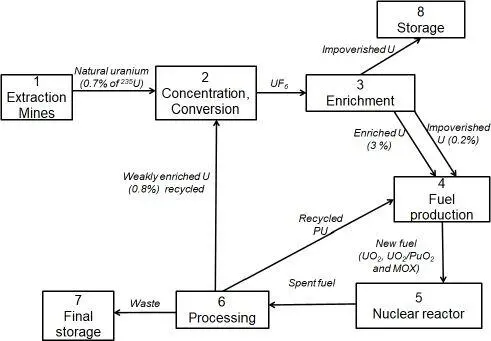
Figure 2.1. The nuclear fuel cycle (modified from [TUR 97, PAT 02, NAU 08])
Accidents at uranium mines have the same health consequences as those at all other mines and cannot therefore be identified as nuclear accidents. On the other hand, uranium mines, especially underground uranium mines, are areas where radiation sources are significant. This is owing, in particular, to radon concentrations that can exceed 100,000 Bq.m −3[CCS 11]. This radon comes from the decay of elements of the families of uranium and thorium (mainly uranium 238), which give rise to various radon isotopes (mainly radon 222), which are in a gaseous state and accumulate in mine galleries. Radon isotopes decay in a cascade into various radionuclides that are in a solid state and when inhaled into the lungs are deposited as radioactive dust that may have health consequences (Figure 2.2).
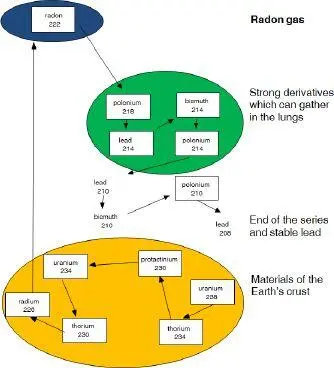
Figure 2.2. The radioactive family of uranium 238 and its derivatives (according to AMI 13a]). For a color version of the figure, see www.iste.co.uk/amiard/industrial.zip
One of the few accidents with environmental and health impacts is one in Puerco, USA. In 1968, 27 km northeast of the town of Gallup, near the town of Church Rock, New Mexico, United Nuclear began operating the largest underground uranium mine in the United States. The mine waste was stored in three large ponds, each closed off by a dike of earth. Residents near the mine were almost entirely native Navajo and used the Puerco River as a source of water for their livestock. In the early morning hours of July 16, 1979, fewer than 4 months after the high-profile Three Mile Island accident was reported, one of the earth dams gave way near Church Rock Mill. The 6 m-wide dam released approximately 1,100 tons of radioactive waste, and 95 million gallons (360 million liters) of effluent reached the Puerco River in North Fork. In addition to the river, groundwater was affected up to more than 130 km downstream of the dike [BRU 07].
2.2.2. Milling, conversion, enrichment and fuel manufacturing plants
The most serious accident in a civilian manufacturing plant is the Tokai-Mura accident. This site is a major nuclear complex, with a spent fuel reprocessing plant, a uranium reprocessing plant and experimental reactors. The site is located in Japan 160 km from Tokyo. The plant where the accident occurred is owned by the Japan Nuclear Fuels Conversion Company (JCO), a subsidiary of the Sumitomo Trust. It converts uranium hexafluoride (UF 6) enriched in uranium 235 into uranium oxide (UO 2) for the manufacture of nuclear fuel. The conversion is carried out by a “wet process”: uranium, initially in the form of gaseous UF 6, is transformed in the presence of water and then ammonia before being calcined in a furnace to obtain uranium oxide powder.
On Thursday, September 30, 1999, at about 3:30 p.m., following a human error in the quantity of fissile material introduced into the furnace, a so-called criticality accident occurred. The quantity of uranium introduced into a settling tank was indeed abnormally high (16.6 kg) and far exceeded the safety level (2.3 kg). This accident resulted in contamination outside the plant, and three workers were seriously injured. It was classified at level 4 on the INES.
Читать дальше
